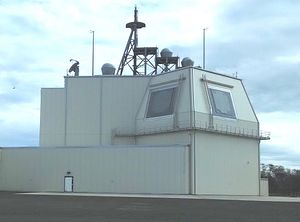Japanese Minister of Defense Itsunori Onodera is expected to visit the U.S. test facility in Hawaii for the ground-based Aegis Ashore system next January, according to Japanese government sources.
“The United States conducts missile intercept tests at the complex on Kauai that Onodera will visit,” Kyodo news agency reports. Japan plans to deploy two Aegis Ashore systems, the land-based version of the Aegis combat system, to defend against China’s and North Korea’s growing ballistic and cruise missile arsenals.
Japan’s Aegis Ashore installations are expected to become operational by 2023. “The government is expected to set aside funds when it drafts the fiscal 2018 budget next month to cover part of the costs of deploying the new missile system,” according to Kyodo.
The Japanese government produced an in-depth study earlier this year concluding that the Aegis Ashore system is more cost effective for missile defense than purchasing the Terminal High Altitude Area Defense system.
The Aegis combat system is an advanced “automated command-and-control and weapons control system built around a (…) multi-function radar system, and capable of tracking up to 100 missiles simultaneously,” I explained elsewhere.
Next to the anti-ballistic missile SM-3 Block IIA interceptor, Japan’s future land-based Aegis sites will likely be armed with the Standard Missile (SM) 6 to specifically defend against Chinese cruise missiles, as I reported last month:
Tokyo is especially concerned over the growing presence of People’s Liberation Army Air Force (PLAAF) Xian H-6K long-range bombers near Japanese airspace. The bomber can be armed with CJ-20 subsonic land-attack cruise missiles with an estimated range of up to 1,500 miles. In the future, PLAAF bombers will also likely be fitted with nuclear-capable cruise missiles.
Beginning in 2018, SM 6 missiles will be deployed aboard Aegis-equipped Japan Maritime Self Defense Force (JMSDF) destroyers. “Manufactured by U.S. defense contractor Raytheon, SM 6 is a supersonic (Mach 3.5+) missile interceptor with an estimated range of over 180 miles,” I wrote last month. “The missile was originally designed for anti-air warfare, anti-surface warfare missions.”
The SM 3 Block IIA is one of the world’s most advanced ‘hit-to-kill’ interceptors. The missile has been under joint development by Raytheon and Japan’s Mitsubishi Heavy Industries since 2006. “It is designed to destroy short- to intermediate-range ballistic missile threats. The SM-3 has been successfully flight tested in February of this year when it destroyed a medium-range ballistic missile target,” I explained previously. “However, the missile failed another intercept test in June.”
Japan’s ballistic missile defense currently consists of Patriot batteries capable of engaging short- and medium-range ballistic missiles in their terminal phase and Aegis destroyers, including the Atagao-class and Kongo-class. Japan plans to field up to eight Aegis-equipped destroyers in the coming years. As I reported last month, in order for a successful intercept to occur, “the Aegis combat system would have to start tracking the missile in its ascent phase and launch interceptors before it overflies the Aegis ashore site,” or Aegis-equipped destroyers.































